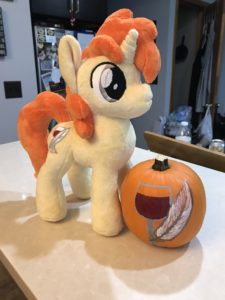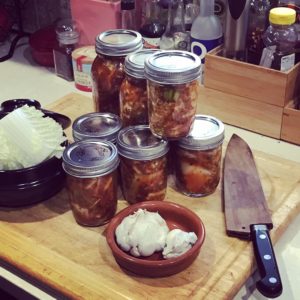Pumpkin spice be damned, pears and apples are in season, so it’s the perfect time for Wine Quill to make… kimchi! Here’s my recipe. Prepare for fermentation. Recipe after the cut!

Wine Quill’s Kimchi
Makes like, a gallon. Om nom nom.
2 largish napa cabbages, about 8 lbs total
1 c kosher salt or coarse sea salt
2 gallons water
2 heads garlic, smashed and peeled
1, 4″ piece of ginger, peeled and sliced
1 tsp sugar
1/2 c fish sauce (omit if vegan)
1 c Korean chili pepper flakes (available at Asian grocers or online)
1 apple, peeled and sliced into chunks
1 pear (preferably Asian), peeled and sliced into chunks
1 onion, peeled and cut into chunks
2 c water
2 bunches scallions, sliced on the bias into 1″ lengths (use the white and green parts; also, if very fat, halve lengthwise)
1 small daikon, peeled, halved lengthwise and sliced into very thin half moons
Special equipment:
rubber gloves
a gallon jar or numerous smaller ones; glass is best as plastic will stain
Slice the cabbages in half lengthwise, and then slice the halves lengthwise once more. Cut out the tough core, then cut each quarter of the cabbage into thirds. You will have an alarmingly large amount of cabbage pieces. Plop them all into a very, very large bowl. Combine the cup of salt with two gallons of water, and pour over the cabbage. You might need two bowls; I sure did. Weigh the cabbage down with a plate or something similar so that it is completely submerged. It needs to sit for 2 to 3 hours.
Meanwhile, prepare the kimchi paste. Place the garlic, ginger, sugar, and fish sauce in the bowl of a food processor and pulse the crap out of it until you have a nice puree. In the very, very large bowl (not plastic unless you want a red bowl; I actually had to use a stockpot), combine the puree with the chili flakes. Add the apple, pear, onion, and 2 cups of water to the same food processor and puree again; this is the substitute for the glutinous rice porridge and adds some sweetness. Stir into the chili flake mixture.
Drain the cabbage and rinse a few times to remove excess salt. Squeeze bunches of it to help get rid of extra water, and plop all the cabbage along with the scallions and daikon into the bowl with the chili flake mixture. WEARING RUBBER GLOVES (unless you want chili burn AND your hands dyed red), thoroughly toss everything in the mixture. Make sure everything gets a nice coating.
Take handfuls of the cabbage mixture and stuff it into the container, pressing down with each addition to get out air bubbles. Continue packing the cabbage tightly until the container is filled, leaving a little space at the top for the gases to expand, and then pour over any extra kimchi juice that might be lingering in the bottom of the bowl. Cover tightly, and leave in a cool, dark place (68 F) for 48 hours.
You can check the kimchi after one day if you fancy. If it’s starting to bubble; it means that it’s started to ferment, which is Good News. If it isn’t, wait a little bit longer. In any case, after fermentation has begun, your kimchi is ready to be refrigerated and, more importantly, eaten. It’ll keep for two weeks in your fridge, but note that it will continue to ferment during this time and gradually become pretty sour (which is the best kind of kimchi to use for cooking things like jjigae).
